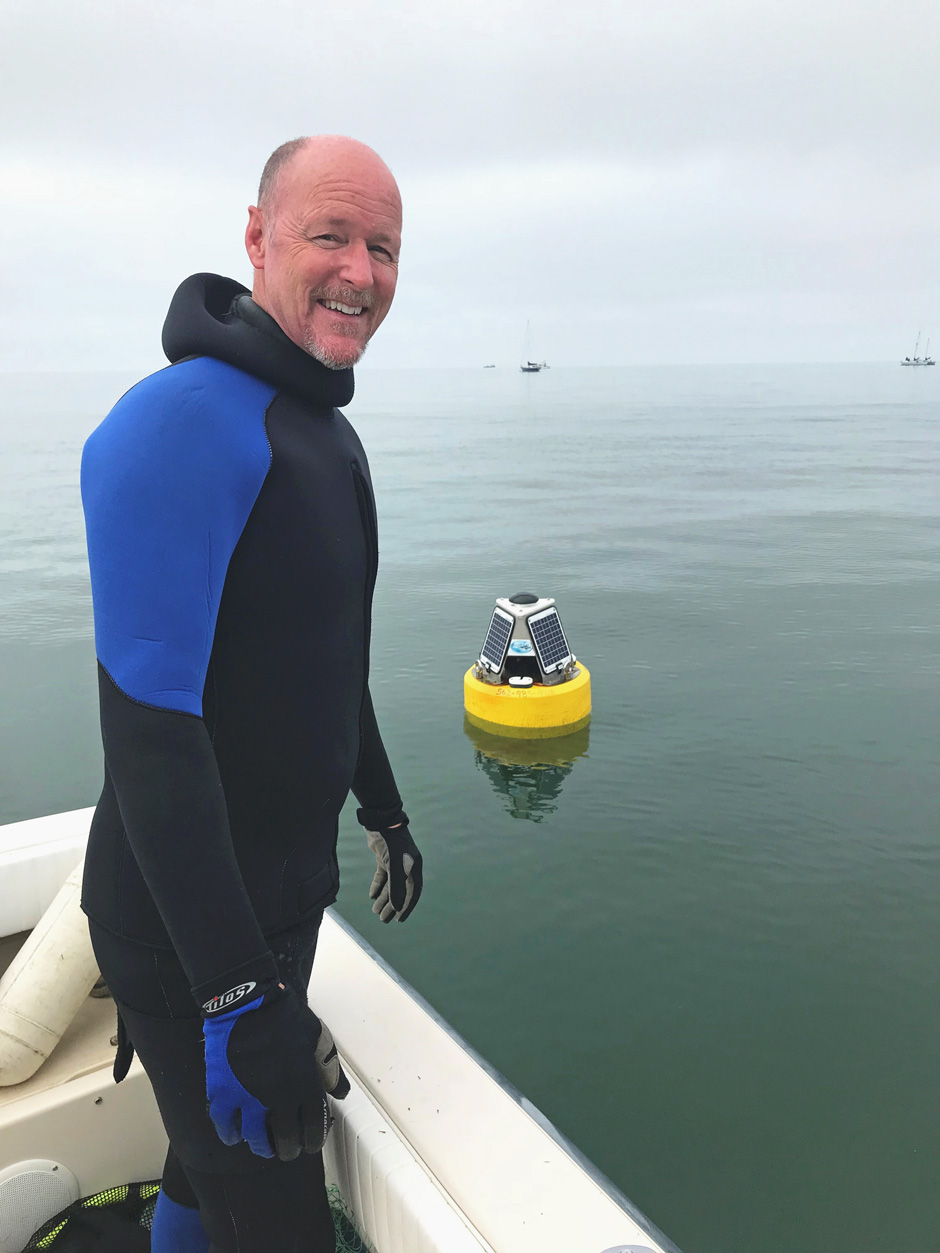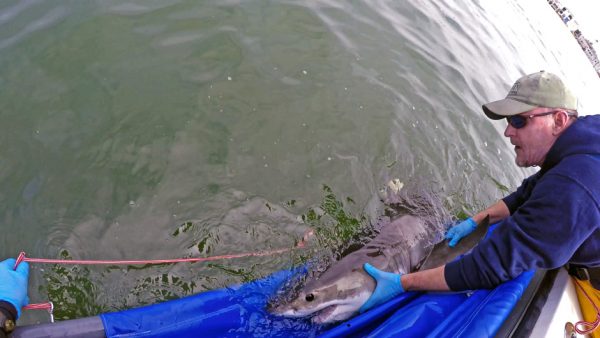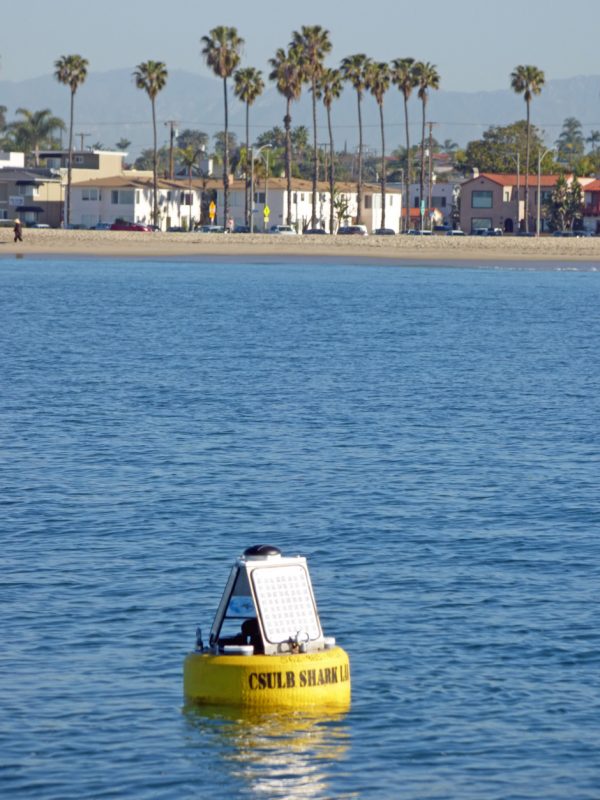Much Remains Unknown About Sharks. The Cal State Shark Lab Wants to Change That
 Shark Lab Director Chris Lowe stands on a boat next to one of the dozens of buoys that collects data on shark species. (Credit: California State University Shark Lab)
Shark Lab Director Chris Lowe stands on a boat next to one of the dozens of buoys that collects data on shark species. (Credit: California State University Shark Lab)Thirty years ago, white shark sightings near California’s beaches almost never happened. For Chris Lowe, who was a graduate student at California State University’s Shark Lab at the time, spying a dorsal fin from one of the ocean’s top predators was very rare.
Prior to the mid-90’s, an expansive commercial fishing operation and the loss of marine animals decimated white shark populations. If their food wasn’t being hunted, sharks were getting caught in gill nets. At that point, they would be killed anyways before getting brought to the market to be sold.
Then in 1994, California residents approved propositions that banned gillnets in state waters and enacted protections for the white shark.
Scientists don’t really know how far the population’s numbers fell, too. But what scientists and Lowe, who currently runs that same shark lab he was a student of, now know is that juvenile white shark sightings have increased, sighting as many as 12 at a beach at the same time.
“They are coming back. It was a shock because they were in trouble for a while. When we started to look at why that is possible, a lot of things made sense,” Lowe said. “These are all juveniles. One of the things we’ve learned – juvenile white sharks use beach habitats and beach lagoons. They spend more time in these areas.”
Whether because the water is warmer or it’s shallower or the food is easier to catch, juvenile white sharks use the California coastline to develop and grow. That wasn’t something scientists understood years ago.
In fact, scientists still don’t know nearly as much as they’d like to know about sharks.
“The challenge has never been public interest. It was always there, but we never had the right technology to answer the best questions posed for 80 years,” said Christopher Lowe. “Now we have those tools, but not the money.”
Unless proposals for grant funding meet the criteria of “Do we eat it?” or “Is it endangered?” financial support from state and federal governments are scant.
But white sharks are returning to California. And while their return is praised as a win for the ecosystem and habitat balance, it also means sharks and people are coming into contact with one another. This means the demand for understanding the behavior and physiology of sharks of all breeds has increased in recent years.
Shark Lab Origins
Most of the Shark Lab’s work can be split into two categories – documenting and studying sharks, and developing technology that will aid those studies. That’s partly why the lab was started in the first place.
“The Shark Lab was founded in 1966 by Dr. Don Nelson, a renowned shark behavior expert. Our goal has always been to find the best ways to study shark behavior and make it available to the public,” said Lowe.

Shark Lab Director Chris Lowe releases a shark back into the sea. (Credit: California State University Shark Lab)
Research that was conducted in its early years was based on developing shark repellents – something the Office of Naval Research was keen on learning more about. But in order to repel sharks, scientists needed to understand the creatures they were repelling.
However, just diving with sharks to observe and study their behavior was too limited. Which is how the lab started dipping its toes into the development industry – researching and building tools that could help them with their work.
That meant placing sensors on sharks that could transmit data wirelessly but also withstand the extreme pressures exhibited by the seas and oceans. And of course, all of it had to be waterproof.
“Anything that’s easy to do on land, the minute you put it in water it becomes so much harder. Saltwater makes it even worse,” Lowe said. “Depending on what it is you’re doing, it can be challenging. Animals can make dives down 1,000 meters.”
A lot of this technology has roots in the military. It should come as no surprise that sonar and telemetry, two tools often used in science were first developed by the military. A lot of the technology that Shark Lab engineers tinker and modify is hand-me-down military technology no longer considered classified.
Once in the hands of marine ecologists and engineers, the technology is adapted for biological applications.
“Basically, what we’ve been doing is taking existing technology and modifying that. The goal is to continue this concept of innovation so we can make giant strides,” Lowe said. “What we’ve learned in the last five years through new tech has exponentially improved upon what we’ve learned over the last 50 years.”
And innovate they did.
Scientists are now using autonomous underwater vehicles and drones to track sharks, people on the beach and how close the two parties are together. There’s the inertial measurement unit (IMU) that acts a little like a Fitbit but for sharks – tracking its motion, acceleration and calorie burn.
Then there are about 100 acoustic receivers that line the California coastline, constantly listening for any transmitters attached to sharks. When a tagged shark comes within a receiver’s range, the receiver logs the time, date and ID number of the transmitter. These units require a diver to pick up the receivers from the seafloor so it can be downloaded. Now they have buoys with cabled receivers that transmit data in real-time using cell modems, along with relevant environmental data – like temperature and depth.
“We’ve been doing all of that for a while now,” Lowe said. “Thirty years ago, we had to build our own transmitters and put it on the animals to follow where it went. We’ve also added sensors to the tags that give us more context.”
Work in the shark lab
All of this innovation is coming at the right time, too. The Shark Lab tracks all kinds of species, from leopard sharks to horn sharks, blue sharks and even the rare megamouth shark. But the lab also tracks local species that sharks feed on, like stingrays.
And understanding how these species interact with each other, their food webs and the changing environment around them will be key in predicting their behaviors for the future.

A buoy run by Cal State University. Buoys collect temperature and depth data. (Credit: California State University Shark Lab)
“Just knowing where animals are going to be isn’t good enough. We need to answer questions on how they make decisions,” Lowe said. “to do that we need environmental data as well.”
One application for this data is how sharks might modify their behavior in a changing climate. While some species of white shark can control their body temperatures, they typically prefer cooler waters. As waters continue to warm, Lowe anticipates the distribution of some sharks changing as well.
However, Lowe believes those that will benefit the most from better shark data is the public. But it has to be used appropriately. After the white shark population began to rebound in Australia, there were more reported cases of shark attacks. After the country started tracking shark locations and made that data public to everyone, beachgoers began to use the data like an early warning system, which creates all sorts of problems. Researchers certainly can’t tag every shark out there and there were likely times when untagged sharks were close to beaches, but there was no alarm.
That’s the completely wrong way to think about sharks.
“All of this should be used as an educational tool. We can’t tag every shark, but if we tag a decent number and study their behavior, we start to understand their behavioral patterns, which ultimately will help us share the ocean with them.”
Prior to the white shark’s resurgence, most people didn’t realize how much of the oceans they did share with them. It’s why so many people feared them. But younger generations are growing up more used to seeing sharks – and less scared of them.
It’s a mindset that Lowe wants to capitalize on.
“The time is right to do some of this work because the public sees the sharks through a different lens. Looking through it as they are important to the marine ecosystem, they could be a potential threat – but we don’t know enough,” Lowe said. “So, let’s find out.




0 comments